
René Jules Lalique was a French jeweller, medallist, and glass designer known for his creations of glass art, perfume bottles, vases, jewellery, chandeliers, clocks, and automobile hood ornaments.

Corning is a city in Steuben County, New York, United States, on the Chemung River. The population was 10,551 at the 2020 census. It is named for Erastus Corning, an Albany financier and railroad executive who was an investor in the company that developed the community. The city is best known as the headquarters of Fortune 500 company Corning Incorporated, formerly Corning Glass Works, a manufacturer of glass and ceramic products for industrial, scientific and technical uses. Corning is roughly equidistant from New York City and Toronto, being about 220 miles (350 km) from both.

Art glass is a subset of glass art, this latter covering the whole range of art made from glass. Art glass normally refers only to pieces made since the mid-19th century, and typically to those purely made as sculpture or decorative art, with no main utilitarian function, such as serving as a drinking vessel, though of course stained glass keeps the weather out, and bowls may still be useful.
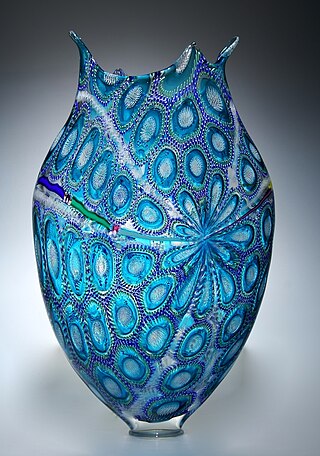
Studio glass is the modern use of glass as an artistic medium to produce sculptures or three-dimensional artworks in the fine arts. The glass objects created are intended to make a sculptural or decorative statement, and typically serve no useful function. Though usage varies, the term is properly restricted to glass made as art in small workshops, typically with the personal involvement of the artist who designed the piece. This is in contrast to art glass, made by craftsmen in factories, and glass art, covering the whole range of glass with artistic interest made throughout history. Both art glass and studio glass originate in the 19th century, and the terms compare with studio pottery and art pottery, but in glass the term "studio glass" is mostly used for work made in the period beginning in the 1960s with a major revival in interest in artistic glassmaking.

Corning Incorporated is an American multinational technology company that specializes in specialty glass, ceramics, and related materials and technologies including advanced optics, primarily for industrial and scientific applications. The company was named Corning Glass Works until 1989. Corning divested its consumer product lines in 1998 by selling the Corning Consumer Products Company subsidiary to Borden.

Kosta Boda, formerly known as Kosta Glasbruk, is a Swedish glassmaking company that is a well known manufacturer of art glass and tableware. It is located in Kosta, Sweden, which was named for the company. The surrounding region has become known as the Kingdom of Crystal, and is now a tourist site which attracts a million visitors annually.
Frederick Carder was a glassmaker, glass designer, and glass artist who was active in the glass industry in both England and the United States, notably for Stevens & Williams and Steuben, respectively. Known for his experimentation with form and color, Carder's work remains popular among collectors and can be found in numerous museum collections, including The Corning Museum of Glass, which houses theFrederick Carder Gallery, Chrysler Museum of Art, and the Detroit Institute of Arts. He was born in Staffordshire, England, and died in Corning, New York, where he had made his home in 1903.

The Corning Museum of Glass is a museum in Corning, New York in the United States, dedicated to the art, history, and science of glass. It was founded in 1951 by Corning Glass Works and currently has a collection of more than 50,000 glass objects, some over 3,500 years old.
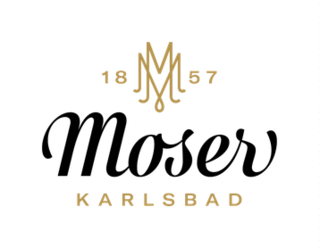
Moser a.s. is a luxury glass manufacturer based in Karlovy Vary, Czech Republic. The company is known for manufacturing stemware, decorative glassware, glass gifts and various art engravings. Moser is one of the most collected of 20th century decorative glass and has been used everywhere from palaces to local restaurants. From its beginnings in 1857, as a polishing and glass engraving workshop, it developed into a lead-free glass manufacturer lasting through the 20th century until the present. It is considered as the most luxurious Czech brand as well as one of the world's most famous brands of luxury crystal. Every piece of glass that is made by Moser is hand made.

Cameo glass is a luxury form of glass art produced by cameo glass engraving or etching and carving through fused layers of differently colored glass to produce designs, usually with white opaque glass figures and motifs on a dark-colored background. The technique is first seen in ancient Roman art of about 30 BC, where it was an alternative to the more luxurious engraved gem vessels in cameo style that used naturally layered semi-precious gemstones such as onyx and agate. Glass allowed consistent and predictable colored layers, even for round objects.

Dan Owen Dailey is an American artist and educator, known for his sculpture. With the support of a team of artists and crafts people, he creates sculptures and functional objects in glass and metal. He has taught at many glass programs and is professor emeritus at the Massachusetts College of Art, where he founded the glass program.

Glass art refers to individual works of art that are substantially or wholly made of glass. It ranges in size from monumental works and installation pieces to wall hangings and windows, to works of art made in studios and factories, including glass jewelry and tableware.
Early American molded glass refers to glass functional and decorative objects, such as bottles and dishware, that were manufactured in the United States in the 19th century. The objects were produced by blowing molten glass into a mold, thereby causing the glass to assume the shape and pattern design of the mold. When a plunger rather than blowing is used, as became usual later, the glass is technically called pressed glass. Common blown molded tableware items bearing designs include salt dishes, sugar bowls, creamers, celery stands, decanters, and drinking glasses.
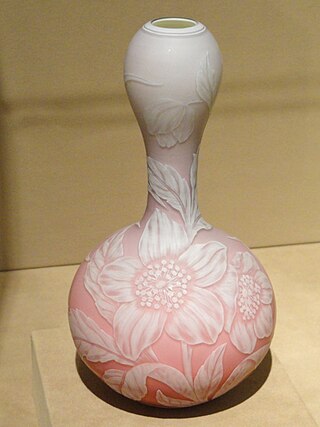
Stevens & Williams was an English glass company located in Stourbridge, established in 1776 under the name of Honeybourne. It is one of the oldest crystal glass brands in England. In the late 1930s it became known as Royal Brierley, and mostly made fine cut glass brand. It is now owned by Dartington Crystal and based in North Devon.
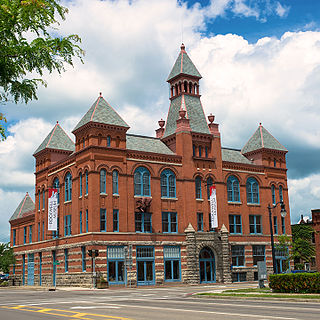
The Rockwell Museum is a Smithsonian Affiliate museum of American art located in the Southern Tier region of New York in downtown Corning, New York. Frommer's describes it as "one of the best-designed small museums in the Northeast." In 2015, The Rockwell Museum was named a Smithsonian Affiliate, the first in New York State outside of New York City.

Pairpoint Glass Company is an American glass manufacturer based in Sagamore, Massachusetts. It is currently the oldest operating glass company in the United States.

Amber Cowan is an American artist and educator living and working in Philadelphia. Cowan creates fused and flameworked glass sculptures from cullet and recycled industrial glass.

Art Nouveau glass is fine glass in the Art Nouveau style. Typically the forms are undulating, sinuous and colorful art, usually inspired by natural forms. Pieces are generally larger than drinking glasses, and decorative rather than practical, other than for use as vases and lighting fittings; there is little tableware. Prominently makers, from the 1890s onwards, are in France René Lalique, Emile Gallé and the Daum brothers, the American Louis Comfort Tiffany, Christopher Dresser in Scotland and England, and Friedrich Zitzman, Karl Koepping and Max Ritter von Spaun in Germany. Art Nouveau glass included decorative objects, vases, lamps, and stained glass windows. It was usually made by hand, and was usually colored with metal oxides while in a molten state in a furnace.
Arlon Bayliss is a visual artist, glass sculptor, and emeritus professor of art at Anderson University, known for his monumental public art installations in Indiana, as well as for his studio glass and factory art glass represented in European art museum collections. Bayliss has designed glass art series for companies such as Rosenthal, Steuben, Blenko and EOS Murano.
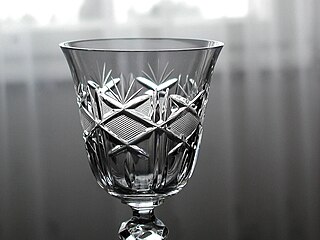
Cut glass or cut-glass is a technique and a style of decorating glass. For some time the style has often been produced by other techniques such as the use of moulding, but the original technique of cutting glass on an abrasive wheel is still used in luxury products. On glassware vessels, the style typically consists of furrowed faces at angles to each other in complicated patterns, while for lighting fixtures, the style consists of flat or curved facets on small hanging pieces, often all over. Historically, cut glass was shaped using "coldwork" techniques of grinding or drilling, applied as a secondary stage to a piece of glass made by conventional processes such as glassblowing.



















